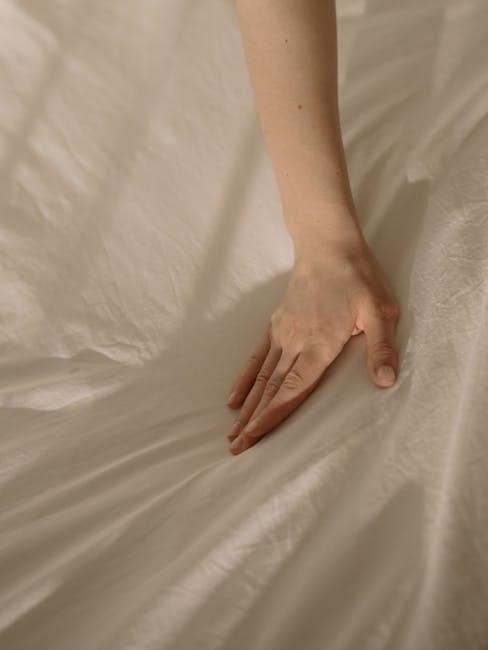Bedroom Cleaning Checklist PDF: A Comprehensive Guide
A bedroom cleaning checklist PDF is a valuable tool for maintaining a tidy and healthy sleeping space․ It outlines tasks to be performed regularly, ensuring no area is overlooked․ From decluttering to deep cleaning, this guide offers a structured approach, promoting a consistently clean bedroom․

A bedroom cleaning checklist is more than just a list; it’s a roadmap to a cleaner, healthier, and more organized personal space․ These checklists come in various formats, often as a PDF, offering a structured approach to tackling the often-overlooked task of bedroom maintenance․ They serve as a visual reminder of what needs to be done, breaking down the cleaning process into manageable steps․ Whether it’s a daily tidy-up, a weekly refresh, or a monthly deep clean, a well-designed checklist ensures consistency and thoroughness․

The benefits of using a bedroom cleaning checklist extend beyond mere aesthetics․ A clean bedroom contributes to improved sleep quality, reduced stress levels, and a greater sense of overall well-being․ By systematically addressing clutter, dust, and germs, these checklists help create a sanctuary of calm and relaxation․ Furthermore, involving family members, especially children, in the cleaning process becomes easier with a clear, shared checklist, fostering responsibility and teamwork․ With a printable PDF checklist, maintaining a pristine bedroom becomes an achievable and rewarding endeavor;
Daily Bedroom Cleaning Tasks
Daily bedroom cleaning tasks are essential for maintaining a tidy and inviting space, preventing clutter from accumulating and dust from settling․ These tasks are quick and easy to incorporate into your routine, setting the stage for a more thorough cleaning on a weekly or monthly basis․ One of the most important daily tasks is making the bed, which instantly creates a sense of order and calm in the room․ Additionally, clearing nightstand surfaces of clutter, such as books, glasses, and electronics, helps maintain a peaceful environment conducive to sleep․
Putting away clothes, whether hanging them in the closet or placing them in the laundry basket, prevents them from becoming scattered around the room․ Emptying the trash can regularly ensures that unpleasant odors and germs don’t linger․ A quick floor scan to pick up any loose items or debris also contributes to the overall cleanliness․ By consistently performing these small daily tasks, you can keep your bedroom looking and feeling fresh, creating a more relaxing and enjoyable space․
Weekly Bedroom Cleaning Tasks
Weekly bedroom cleaning tasks are crucial for maintaining a healthy and comfortable environment, going beyond the daily tidying to address more significant cleaning needs․ One of the most important weekly tasks is changing and washing bed sheets, pillowcases, and blankets, eliminating accumulated dust mites, allergens, and bacteria․ Dusting all surfaces, including furniture, shelves, and window sills, prevents dust buildup and improves air quality․ Vacuuming or mopping the floors removes dirt, dust, and debris, creating a cleaner and more hygienic space․
Emptying and cleaning the trash can helps prevent unpleasant odors and the spread of germs․ Wiping down mirrors and glass surfaces removes streaks and smudges, enhancing the room’s appearance․ Decluttering and tidying visible areas, such as dressers and desks, keeps the space organized and functional․ Dusting ceiling fans and light fixtures prevents dust from circulating in the air․ By incorporating these weekly tasks into your cleaning routine, you can maintain a clean, fresh, and inviting bedroom environment, promoting better sleep and overall well-being․
Monthly Bedroom Cleaning Tasks
Monthly bedroom cleaning tasks involve a more thorough approach to maintaining a clean and organized space, addressing areas often overlooked in weekly cleaning․ One essential task is washing curtains or blinds to remove accumulated dust and allergens, improving air quality and the overall cleanliness of the room․ Cleaning windows, both inside and out, enhances natural light and provides a clearer view․ Vacuuming or cleaning under furniture, such as beds and dressers, removes hidden dust and debris, preventing allergen buildup․
Washing or dry-cleaning comforters and duvets ensures they remain fresh and hygienic․ Organizing and decluttering drawers and closets helps maintain order and maximize storage space․ Cleaning and conditioning wooden furniture preserves its appearance and extends its lifespan․ Checking and cleaning air vents ensures proper airflow and prevents dust accumulation․ Addressing any spots or stains on carpets or rugs keeps them looking their best․ By performing these monthly tasks, you can maintain a consistently clean, healthy, and inviting bedroom environment, contributing to a more comfortable and relaxing living space․
Essential Cleaning Supplies Checklist
Having the right cleaning supplies on hand is crucial for efficiently maintaining a spotless bedroom․ A microfiber cloth is essential for dusting surfaces without scratching, ensuring a gentle yet effective clean․ A vacuum cleaner with various attachments is indispensable for thorough floor cleaning, reaching under furniture and in corners․ Furniture polish helps maintain the luster of wooden furniture, while glass cleaner ensures mirrors and windows are streak-free and sparkling․
Lysol wipes are perfect for quick disinfection of frequently touched surfaces, such as doorknobs and light switches․ A long-handled duster assists in reaching high areas like ceiling fans and light fixtures, removing dust without straining․ A trash bag and basket are necessary for collecting and disposing of waste efficiently․ Additionally, consider having specialized cleaners for carpets or upholstery to address any stains or spills promptly․ Keeping these supplies readily available streamlines the cleaning process, making it easier to maintain a clean and healthy bedroom environment, contributing to overall well-being and comfort․

Decluttering and Organizing the Bedroom
Decluttering and organizing your bedroom are essential steps toward creating a serene and functional space․ Begin by removing any items that don’t belong in the bedroom, such as books, electronics, or other clutter that has accumulated over time․ Next, focus on your closet and drawers․ Evaluate your clothing, accessories, and shoes, and set aside items you no longer wear or need․
Consider donating or selling these items to create more space․ Store seasonal clothing in designated containers or vacuum-sealed bags to maximize space․ Implement an organization system using dividers, shelves, or storage bins to keep items neatly arranged and easily accessible․ Organize and put away accessories like jewelry, belts, and scarves in designated spots․ Evaluate clothing that needs to be thrown away due to damage or wear․ Clear nightstand surfaces and other visible areas, removing unnecessary items․ By decluttering and organizing, you create a more peaceful and inviting bedroom environment․

Changing and Washing Bedding
Changing and washing your bedding regularly is crucial for maintaining a clean and healthy sleep environment․ Aim to change your sheets, pillowcases, and blankets at least once a week․ This helps to remove dust mites, allergens, and body oils that accumulate over time․ Before washing, strip the bed completely, removing all sheets, pillowcases, blankets, and comforters․
Wash your bedding in hot water with a quality detergent to effectively kill germs and bacteria․ Follow the care instructions on the labels to avoid damaging the fabrics․ For heavily soiled items, consider using a laundry booster or soaking them before washing․ After washing, promptly dry your bedding thoroughly to prevent mildew growth․ Clean your mattress protector regularly, following the manufacturer’s instructions․ Changing and washing your bedding weekly ensures a fresh and hygienic sleeping space, contributing to better sleep quality and overall health․ Remember to spot clean any stains on your comforter or duvet cover as needed․
Dusting Surfaces and Fixtures
Dusting surfaces and fixtures is an essential part of bedroom cleaning, as dust accumulates quickly and can trigger allergies․ Begin by using a long-handled duster to reach ceiling fans and light fixtures, removing any cobwebs or accumulated dust․ Next, dust all surfaces, including furniture, window sills, and blinds, working from top to bottom to prevent dust from settling on already cleaned areas․

Use microfiber cloths for effective dust removal, as they trap dust particles rather than just spreading them around․ For furniture, consider using a furniture polish to protect the wood and add shine․ Don’t forget to dust decorative items and picture frames, as these can also collect dust․ Regularly dusting surfaces and fixtures not only improves the appearance of your bedroom but also enhances air quality by reducing allergens․ Remember to dust under the bed and behind furniture periodically as well․ Effective dusting contributes to a cleaner, healthier, and more comfortable bedroom environment․
Vacuuming and Floor Cleaning

Vacuuming and floor cleaning are crucial steps in maintaining a clean and healthy bedroom․ Start by removing any loose items from the floor, such as clothes or small objects, to ensure a thorough cleaning․ Use a vacuum cleaner with appropriate attachments to reach under the bed, along baseboards, and in corners where dust and debris tend to accumulate․ For carpets and rugs, use a vacuum with a beater bar to lift dirt and dust from the fibers, paying extra attention to high-traffic areas․
If you have hardwood, tile, or laminate flooring, use a vacuum with a soft brush attachment to avoid scratching the surface․ After vacuuming, consider mopping hard floors with a suitable cleaning solution to remove any remaining dirt and grime․ Ensure the floor is completely dry to prevent slips and water damage․ Regular vacuuming and floor cleaning not only improve the appearance of your bedroom but also help to reduce allergens and dust mites, contributing to a healthier living environment․ A clean floor enhances the overall cleanliness and comfort of the bedroom․
Window and Mirror Cleaning

Cleaning windows and mirrors is an essential part of maintaining a bright and inviting bedroom․ Start by gathering your supplies: a spray bottle filled with glass cleaner or a mixture of water and vinegar, a microfiber cloth, and a squeegee (optional)․ Begin by spraying the glass cleaner onto the window or mirror surface, ensuring even coverage․ Use a microfiber cloth to wipe the surface, removing dirt, dust, and smudges․ For larger windows, consider using a squeegee to achieve a streak-free finish․ Overlap each stroke of the squeegee slightly to prevent leaving any lines․
Pay attention to corners and edges, as these areas often accumulate dirt․ If you encounter stubborn spots, apply additional cleaner and let it sit for a few moments before wiping again․ For mirrors, be careful not to spray cleaner directly onto the frame, as this can damage the finish․ Instead, spray the cleaner onto the cloth and then wipe the mirror․ Cleaning windows and mirrors regularly not only improves their appearance but also allows more natural light to enter the room, creating a brighter and more pleasant atmosphere․ A streak-free shine enhances the overall cleanliness of the bedroom․
Using Printable Checklists for Efficiency
Printable checklists are invaluable for boosting efficiency in your bedroom cleaning routine․ By providing a structured framework, these checklists ensure that no task is overlooked, saving time and effort․ Start by downloading a bedroom cleaning checklist PDF tailored to your needs, whether it’s a daily, weekly, or monthly checklist․ Keep the checklist readily accessible, perhaps on a clipboard or attached to the refrigerator, as a constant reminder of pending tasks․

As you complete each item on the list, mark it off to track your progress and experience a sense of accomplishment․ This simple act of checking off tasks can be surprisingly motivating․ Regularly reviewing the checklist allows you to identify areas that may need more attention or tasks that are frequently skipped․ Consider laminating the checklist for durability and using a dry-erase marker to mark off completed tasks, making it reusable․ Printable checklists not only streamline the cleaning process but also help establish consistent cleaning habits, leading to a consistently tidy and organized bedroom․ Using a structured approach keeps you focused and efficient․

